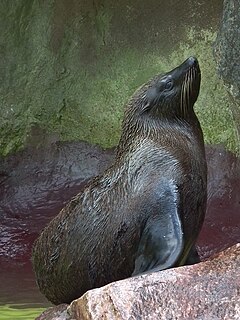
Diporiphora is a genus of lizards in the family Agamidae. Most species in the genus are endemic to Australia, but two are also found in New Guinea.

The South American fur seal breeds on the coasts of Peru, Chile, the Falkland Islands, Argentina, Uruguay and Brazil. The total population is around 250,000. However, population counts are sparse and outdated. Although Uruguay has long been considered to be the largest population of South American fur seals, recent census data indicates that the largest breeding population of A. a. australis are at the Falkland Islands followed by Uruguay. The population of South American fur seals in 1999 was estimated at 390,000, a drop from a 1987 estimate of 500,000 - however a paucity of population data, combined with inconsistent census methods, makes it difficult to interpret global population trends.

Burchell's starling or Burchell's glossy-starling, is a species of starling in the family Sturnidae. The monogamous and presumably sedentary species is native to dry and mesic woodlands and savannah of southern Africa. The name of this bird commemorates the English naturalist William John Burchell.
Diporiphora adductus, the Carnarvon dragon, is a species of agama found in Australia.
Diporiphora albilabris, the white-lipped two-line dragon or tar tar lizard, is a species of agama found in Australia.
Diporiphora ameliae is a species of agama found in Australia.
Diporiphora bennettii, also known commonly as the Kimberley sandstone dragon or the robust two-line dragon, is a species of lizard in the family Agamidae. The species is endemic to Australia.

Diporiphora bilineata, the northern two-line dragon or two-lined dragon, is a species of agama found in Australia and Papua New Guinea.

Diporiphora convergens, the Crystal Creek two-lined dragon, is a species of agama found in Australia.
Diporiphora lalliae, the northern deserts dragon or Lally's two-line dragon, is a species of agama found in Australia.

Diporiphora linga, the pink two-line dragon, is a species of agama found in Australia.

Diporiphora magna, the yellow-sided two-lined dragon, is a species of agama found in Australia.
Diporiphora nobbi, the nobbi lashtail or nobbi, is a species of agama found in Australia.
Diporiphora paraconvergens, the grey-striped western desert dragon, is a species of agama found in Australia.
Diporiphora phaeospinosa is a species of agama found in Australia.
Diporiphora pindan, the Pindan two-line dragon or Pindan dragon, is a species of agama found in Australia.
Diporiphora reginae, the plain-backed two-line dragon, is a species of agama found in Australia.
Diporiphora superba, the superb two-line dragon, is a species of agama found in Australia.
Diporiphora valens, the southern Pilbara spinifex dragon , southern Pilbara tree dragon, or Pilbara two-line dragon, is a species of agama found in Australia.
Diporiphora vescus, the northern Pilbara tree dragon, is a species of agama found in Australia.








